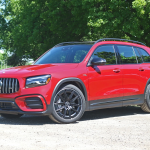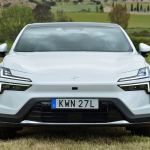Those of us gathered at the foot of the San Gabriel mountains just north of Los Angeles know our time here will be exquisite, eviscerating and excessive all at once — we are children of the liberated cortex and it is our duty to inform you of the haunting pleasures baked into the 2017 Chevrolet Camaro ZL1.
Almost everyone makes fast metal these days – from 500-horsepower grocery getters to felony-prone family sedans – but this is different, this is a serious soundtrack punctuated with full-bodied fury. This is immaculate sanity.
If you think about it, no one needs $63,453 ($69,200 CAD) worth of supercharged spitfire, nor a 10-speed transmission calibrated by a mad scientist who knows what you want before you need it. But, hey, we don’t usually want what we need, but we definitely, always, need what we want.
The new Camaro ZL1 tips in with 200 lb (90 kg) less weight to lug around, plus an extra 70 more horsepower and 94 more lb-ft of twist compared to the fifth-gen car. Pilfered from the Corvette Z06 – minus its dry sump oiling system – is the ZL1’s 650 horsepower, supercharged 6.2-liter V8. The LT4 is a literal loudmouth that barks atavistically whenever your right shoe solicits, but it’s the car’s 650 pound-feet of torque that will swallow whole you without chewing.
How do you tame such a savage beast?
With savagely smart electronic wizardry, that’s how. Camaro Chief Al Oppenheiser and his crew threw every trick they could at the 2017 Chevrolet Camaro ZL1, including an all-new 10-speed transmission (a $1,595 option), a new electronic limited-slip differential, and a suite of track and performance applications to help you harass the trembling tarmac.
Same, Same, But Different
It’s easy to think of the Camaro ZL1 as a 1LE that sniffed too much speed on a Saturday, but that would be a gross oversimplification of the overwrought engineering that went into the ZL1 program.
From the windshield forward, the ZL1’s sheet metal is totally bespoke — the aluminum hood was given new aero-optimized surfacing with a carbon fiber scoop to suck hot air away from the 1.7-liter supercharger, and 16 mm wider front fenders to accommodate 10 heat exchangers jammed into the engine bay.
ALSO SEE: 2017 Chevrolet Camaro 1LE Review
The wider face and high-flow grille also force feed gulps of cold air to the gargantuan 15.35-inch (390-mm) front rotors and six-piston Brembo calipers. Aaron Link, the ZL1’s lead development engineer, tells us the front brakes are actually the largest iron discs ever offered on a Camaro, sharing diameter with the fifth-gen Camaro Z28’s carbon-ceramic rotors. The rear wheels make do with 14.4-inch (365-mm) rotors that are bitten by four-piston Brembos.
The Tremec TR-6060 six-speed manual makes another cameo in the Camaro with new gear ratios and a heavier clutch, and so do Goodyear’s Eagle F1 Supercar 3 tires (285 front, 305 rear), which wrap 20-inch forged aluminum wheels. GM’s magical magnetorheological dampers have been made better thanks to a second magnetic coil that improves dampening response rate and overall capability by 40 percent.
Helping turn torque into thrust is GM’s slick eLSD, which Link calls a “major tuning element for dynamic response.” By pushing standard clutch packs together using hydraulic pressure, it’s capable of up to 2000 Nm of coupling torque – a standard mechanical LSD can only hang on until 200 Nm. The eLSD’s real party trick, however, is its ability to vary coupling based on steering trace and throttle inputs.
On corner entry, the diff is able to gradually reduce coupling as the steering moves away from center and the throttle gets light; then on exit, it starts to recouple in step with steering angle coming down and throttle demands getting heavy.
Behind the scenes, GM’s five-mode Performance Traction Management system acts as an invisible hand helping to fill in the gaps between talent and ambition. Atypically, when you move the ZL1 into more aggressive modes, throttle response flattens for a smoother power delivery.
Hang Ten
Where the ZL1 begins to set itself apart from the other jets GM sells is the brand new, never used, Hydra-Matic 10R90 10-speed automatic transmission.
GM doesn’t mind admitting the transmission was born from a beast with two backs, but that doesn’t mean the genes are bad. Yes, the base 10-speed design and 7.39 ratio spread is shared with the “other partner” that cannot be named (Ford), but the ZL1 gains a new torque converter, clutch components, planetary carriers, output gearsets, and software.
First gear is an in your face 4.70 ratio, which then steps down in small increments until the 1:1 seventh gear; everything after that is basically overdrive. Goons will accuse the 10-speed of being weird, and totally brown-nosing CAFE fuel economy targets, but they’re not capable of grasping just what this transmission means to raw pace.
Jim Borgenson, the assistant chief engineer of the new transmission, is practically glowing as he explains how more ratios mean more performance. “If you want to have wider performance windows, you have to have a certain ratio span to match what the engine can do to what the vehicle really wants.”
The 10-speed allows the LT4 to constantly stay in
the fat bit of its rev range, which Borgenson describes as “more chances” to optimize what the engine can provide, when the car wants, and when the driver needs it.
Borgenson’s partner in crime, lead calibrator Jeff Trush, calls it “sportbike-esque” because of the micro-drops in engine speed as the transmission flips through gears faster than you can process the logic. I call it a bottomless pit of torque.
Trush and his team are responsible for the ZL1’s progressive performance shifting algorithms. The base level uses simple throttle and brake inputs to switch into Performance Lift mode, where it will hold gears when you lift out of the throttle during spirited driving to prevent superfluous upshifting and downshifting.
If the car notices heavier throttle and brake applications accompanied by lateral acceleration rates above 0.65g, it will switch into Performance Shift mode, stretching shift points out to 4,700 rpm.
When g-forces, acceleration, and brake rates punch through an even higher threshold, the 10R90 will switch into High-Performance Shift mode, holding gears all the way to redline and downshifting in the most aggressive way possible.
In fact, when ride and handling engineer Drew Cattel hot-footed a ZL1 around the Nurburgring in 7:29.60, he was using the top-shelf shift algorithm, letting the car dictate which gear and when. Trush gushes about how on Cattel’s run, the 10R90 made a 7th to 8th gear upshift at 170+ mph into the off camber Tiergarten lefthander after the never-ending Döttinger Höhe straight.
ALSO SEE: Ford Shelby Mustang GT350 Review
Either in full auto or using the paddles, shifts happen inside of 300 milliseconds; tap shifting is slower, but only because your fingers aren’t fast enough. The transmission isn’t perfect – at times it would find itself hung on a gear, almost unsure if it should grab another – but it’s damn close.
Hammer Down
We’re at the legendary Willow Springs and I’m jittery and on edge. Chain smoking, unable to shake the realization that I’m about to strap myself into the most powerful Camaro ever built to hot lap one of the fastest tracks in the country, not to mention one of the worst maintained.
I just watched IndyCar star Josef Newgarden step out of a 10-speed ZL1 and call this place “f–king gnarly.” The tarmac at Willow is bumpy and narrow, the apex curbs are crumbling from decades of abuse, and where the tarmac ends the desert begins – how else am I supposed to feel?
Whatever.
Zuuttt, screams the supercharger overtop the exhaust’s rhythmic raaaawwllll, hook another gear, SPLAT – more please – zuuuuttttt, raaaaaawwwwwwlll, SPLAT – YES, MORE – zuuuuuuuuuutttttt, rawwwwaaawwwwwwllllllllllll, SPLAT — oh my god is there actually more???
When aimed in the right direction at high speed, the ZL1 has unnatural capabilities.
Turn 2 at Willow is long sweeping right-hander littered with bumps, making the car squirm under 1.20g cornering loads. Feeding it more gas off the apex, the 10-speed slips into fifth for the short shoot to the uphill Turn 3, then under braking, the ZL1 fires off a pair of quick downshifts, literally vacuuming the car down to the apex. Square off Turn 4 for the run down to 5, which sets up the immaculate blind transition at Willow’s Turn 6, which can be attacked nearly flat, letting the PTM do its thing as the rear end gets light before launching onto the triple-digit back straight.
Around Big Willow, the car is terrifying until the point where fear paradoxically turns to fun, electromechanical intoxication scattering senses, spitting thunder – it’s the perfect partner in crime: hell bent, controlled, crazy and definitely ready for ruckus.
The Car That Makes Manual Transmissions Irrelevant
There’s no room for pointless nostalgia because, in this business, you better move ahead in quantum leaps. Plain and simple, the manual ZL1 is an irrelevant memento from the last millennium.
Rowing gears yourself will forever amuse, and the six-speed ZL1 amuses like any other high horsepower, rear-drive car; but I don’t want to be amused – I want to be enamored. The new 10-speed transmission does just that and more.
The Verdict: 2017 Chevrolet Camaro ZL1 Review
With more gears than a Formula One car and driving dynamics that will make Porsches weep, the new transmission offers newfound control of the car underneath you; it’s no longer a conversation, it’s a synthesis, you don’t need to communicate with the 10-Speed ZL1, your brains are wired together.
I am a slave to speed, and the 2017 Chevrolet Camaro ZL1 is the democratization of fast.
This article originally appeared on GM Inside News












